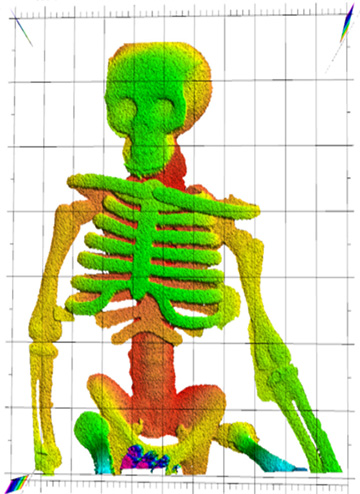
NIST researchers demonstrated that laser ranging could “see through flames” to make this image of a plastic skeleton toy. Laser ranging captured the plastic skeleton’s complex three-dimensional shape, with depth indicated by false color. The plastic did not melt or deform in the fire. [Image: Baumann / NIST]
Structural fires pose some unique challenges, as they’re too hot to measure with conventional electromechanical sensors mounted on buildings. Measuring the deformation of building elements as they’re burning is necessary in fire research to improve safety should a fire occur. To date, no ranging technology has satisfied the prerequisites of being non-contact, able to range at the millimeter scale with sub-millimeter precision, and fast enough to capture heat-induced deformations of the target object while imaging through flames.
Now, researchers at the National Institute of Standards and Technology (NIST) have developed a laser detection and ranging (LADAR) system capable of imaging 3-D objects melting in flames (Optica, doi: 10.1364/OPTICA.5.000988). The team believes that the LADAR setup could potentially be scaled up to enable its application to larger-scale fires and objects.
Imaging and fire safety
Monitoring a burning, deforming object is particularly difficult for a host of reasons—the imaging method must be capable of both seeing through flames and providing high-precision measurements. Measurements must be on the millimeter to meter scale with sub-millimeter precision, which is challenging to obtain in fire’s extreme environmental conditions. Electromechanical sensors can’t be used as they require direct-contact measurement, which isn’t feasible when gas temperatures top 1200 °C. Traditional imaging techniques are deterred by fire spectrum interference.
The NIST researchers turned to contactless optical 3-D distance metrology to overcome these hurdles. They settled on frequency-modulated continuous-wave (FMCW) LADAR as the best method to capture 3-D point clouds of deforming objects through flames with traceable precision. (LADAR is also commonly referred to as lidar, which stands for light detection and ranging.) FMCW LADAR uses heterodyne detection, which is robust against fire’s background radiation, even at 1560 nm (close to typical flame temperatures). FMCW LADAR is also sensitive (photon-efficient) enough to enable imaging even amid soot. It can operate at a distance, out of harm’s way, and the combination of fiber optic delivery and single-element photodetection lends itself to a portable, compact setup.
Making movies
The team’s setup consists of a laser that continuously sweeps the flame-obstructed object across a band of optical frequencies using a fast-steering mirror (FSM). Range measurements are taken continuously at a 1-kHz update rate, and each measurement is corrected for distortion. In the 3-D mapping system, the resulting 3-D point cloud is then transformed to obtain Cartesian coordinates to form the 3-D image.
In three experiments with a piece of chocolate, an aluminum block and a plastic toy, the NIST team retrieved 3-D point clouds at high-ranging precisions. By making movies of the melting objects, the team showed that the system is fast enough to capture temperature-induced deformations (such as melting chocolate) at 30-µm ranging precision from a 2-m distance. The deflections of the laser beam due to the flames, according to the team, can be accommodated by averaging the signals over time.
NIST researchers demonstrated that laser ranging could make a continuous series of “point clouds” of a piece of chocolate melting behind flames. The false color indicates depth, with blue being the closest and red the farthest away. (The 6-min video is sped up to show the deformation process). [Video: Baumann / NIST]
These experiments used just 50-mm-wide lab burner flames, but the team plans to scale up the experiment to 1-m flames, and then eventually image larger structural fires.
